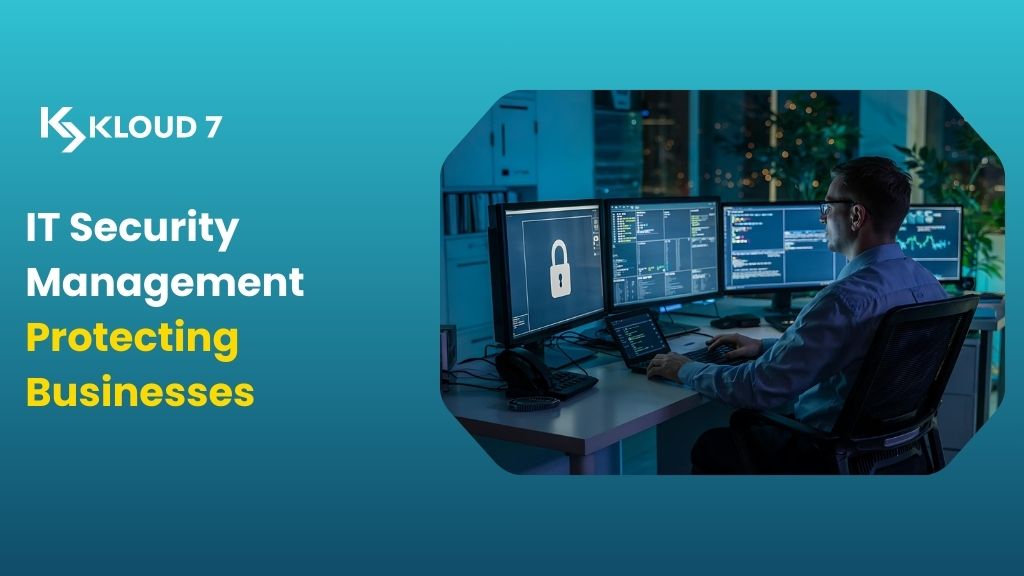Cybersecurity has become one of the biggest concerns for modern businesses. Data breaches, ransomware, phishing, and insider threats are growing at an alarming pace. For companies, this isn’t just a technical issue; it’s a matter of survival. That’s where IT security management steps in.
The goal of IT security management is to protect digital assets, safeguard sensitive data, and ensure that networks remain resilient against evolving cyber risks. It also plays a critical role in compliance, trust, and long-term growth. In this guide, we’ll explore what IT security management is, why it matters, how to build an effective program, and the responsibilities of IT security managers.
What Is IT Security Management?
IT security management refers to the policies, processes, and tools businesses use to protect their IT systems from cyber threats. It goes beyond installing firewalls and antivirus software it involves developing a structured approach to identify risks, apply controls, monitor activity, and respond quickly to incidents.
Core Functions of IT Security Management
- Risk Identification and Prevention – Finding weak points in systems and strengthening them.
- Access Control – Ensuring only authorized users can access specific data or systems.
- Threat Management – Detecting and responding to malware, phishing, or insider threats.
- Compliance Enforcement – Meeting standards like GDPR, HIPAA, or ISO 27001.
Why IT Security Management Matters for Businesses
Protection Against Cyber Threats
The rise of ransomware and advanced phishing attacks underscores why managing IT security is no longer optional. Companies that fail to invest risk data loss, downtime, and reputational damage.
Compliance and Legal Requirements
Laws and regulations demand strong IT compliance management. Non-compliance can lead to fines, lawsuits, and business suspension.
Business Continuity
IT security management ensures operations continue even after an incident. Without a plan, a single breach could halt business for days.
Key Elements of an IT Security Management Program
1. Risk Management in IT Security
A structured risk management in IT security program identifies threats, assesses vulnerabilities, and implements measures to reduce risks. This involves both technical and organizational controls.
Common Risk Categories:
- Data breaches
- Insider misuse
- Weak access controls
- Poor patch management
- Third-party vulnerabilities
2. IT Compliance Management
Compliance ensures companies meet legal and industry requirements. Effective IT compliance management includes:
- Regular audits
- Security awareness training
- Documented security policies
- Data handling best practices
3. IT Security Threat Management
A proactive IT security threat management plan focuses on detecting and mitigating cyber risks before they escalate. Key components include SIEM (Security Information and Event Management) tools, intrusion detection systems, and continuous monitoring.
Roles and Responsibilities in IT Security Management
IT Security Manager Responsibilities
The job description of an IT security manager is extensive. Responsibilities often include:
- Developing and maintaining security policies
- Conducting risk assessments
- Implementing security solutions
- Leading incident response teams
- Ensuring compliance with regulations
- Training employees on security awareness
IT Security Management Program Leadership
Strong leadership is crucial. The manager ensures resources are allocated properly and coordinates with other departments to align IT security goals with business objectives.
IT Network Security Management
Network protection is a core aspect of IT network security management. It involves firewalls, VPNs, segmentation, and encryption to secure communication channels.
Building an Effective IT Security Management Program
Step 1: Assess Current Security Posture
Conduct vulnerability scans, penetration tests, and audits to identify weak spots.
Step 2: Implement Layered Security Controls
Use a combination of firewalls, intrusion detection, endpoint security, and cloud-based monitoring.
Step 3: Establish Policies and Procedures
Document rules on password use, access control, incident response, and employee responsibilities.
Step 4: Train Employees
Humans are often the weakest link. Security awareness training reduces phishing risks and insider mistakes.
Step 5: Monitor and Respond
Continuous monitoring ensures a quick response to attacks. A clear incident response plan is essential.
Comparing IT Security Approaches
| Security Approach | Description | Benefits | Challenges |
| Traditional Security Tools | Antivirus, firewalls, and manual monitoring | Affordable, basic protection | Insufficient against modern threats |
| Managed IT Security Services | Outsourced security operations | 24/7 monitoring, expert response | Ongoing costs |
| IT Security Management Program | Holistic framework (risk, compliance, monitoring) | Comprehensive protection, compliance | Requires strong leadership |
IT Security Management Courses and Training
Many professionals seek IT security management courses to grow their expertise. Popular certifications include:
- CISSP (Certified Information Systems Security Professional)
- CISM (Certified Information Security Manager)
- CompTIA Security+
- ISO 27001 Lead Implementer
These programs prepare managers to lead IT security programs effectively.
Security Risks Mitigated by Managed IT
Businesses often partner with managed IT service providers to strengthen security. Common risks reduced include:
- Malware and ransomware attacks
- Unauthorized access to data
- Insider threats
- Compliance violations
- Downtime due to system outages
FAQs
1. What is IT security management?
IT security management is the structured approach to protecting IT systems, networks, and data through risk assessments, controls, compliance, and monitoring.
2. What are the IT security manager’s responsibilities?
They oversee risk management, threat monitoring, compliance enforcement, and employee training, ensuring the organization’s security framework is strong and up to date.
3. Why is risk management in IT security important?
It helps organizations identify vulnerabilities, prioritize threats, and implement controls to minimize the chance of costly cyber incidents.
4. What is an IT security management program?
It’s a comprehensive framework that combines policies, controls, monitoring, and training to safeguard digital assets and ensure compliance.
5. Are there IT security management courses for professionals?
Yes, certifications such as CISSP, CISM, and CompTIA Security+ provide essential knowledge and skills for effectively managing IT security.
Conclusion
IT security management is no longer an optional part of business; it’s a necessity. From protecting sensitive data to ensuring compliance, its role has grown in importance with every new cyber threat. An effective IT security management program combines risk management, compliance, monitoring, and awareness to create a resilient organization.
Whether you’re a small business or a global enterprise, prioritizing IT security management is the best investment you can make to safeguard your future.
Ready to strengthen your company’s security? Begin by assessing your current risks, implementing layered defenses, and establishing a robust IT security management program today.




